Cereus Peruvianus (Peruvian Apple Cactus) Grow & Care Guide
Written by Iris
Sep 22 2021
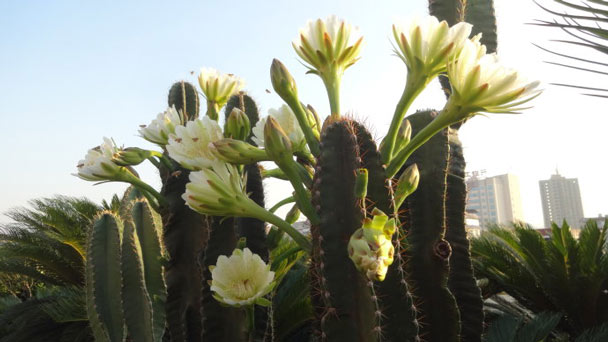
Cereus Peruvianus (Peruvian Apple Cactus) is a tree-like cactus that grows in the shape of a multi-branched candlestick. Individual stems gray-blue to gray-green, deeply ribbed. The stem ribs have a twisted wavy pattern that gives it a unique presence. Highly sought after by collectors. It grows slower and more compact than a standard cactus.
The Cereus Peruvianus appreciates a warm, dry environment with minimal water, and plenty of light. This desert beauty will thrive in high light conditions, so placing it in a window where it will receive direct sunlight is ideal — preferably a southern or western facing window, as they are typically the brightest. This plant will not tolerate low light conditions.
If you are unsure about lighting conditions in your home or office, we have a guide for how to measure light in your space.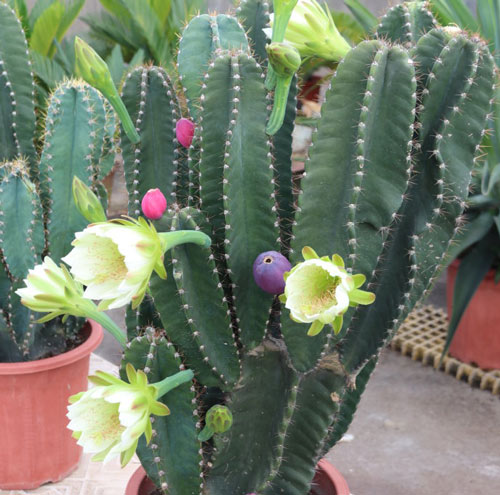
Here is an insight on how to go about the procedure:
Identify a mature Cereus Peruvianus (Peruvian Apple Cactus) plant – A mature plant has several stem extensions from the main stem.
Make a cutting on the stem top part of the Cereus Peruvianus – Carefully make a smooth cutting on the top side of the stem you intend to propagate.
Allow the cutting to dry for about a week or two – Allow the cutting to dry out undisturbed for about one week before planting the dried cutting in an ideal potting medium.
Observe the cutting and analyze its growth pattern – Ensure you don't overwater the plant during this stage, as it can affect the Cereus Peruvianus’s future health and cause unwanted cases of root rot.
Once the Cereus Peruvianus plant is well established, it can be transplanted into the soil of the pot. If you want the growth of the plant to be faster, you can place it in areas where the light is brighter.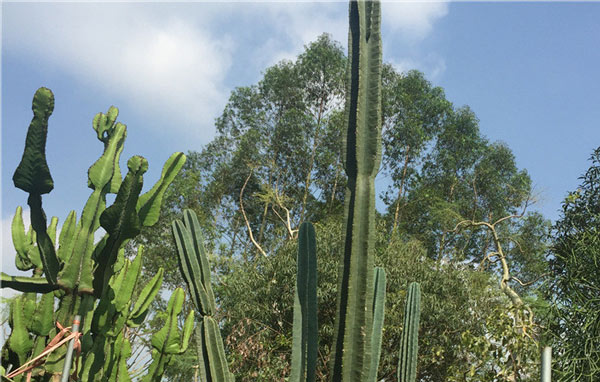
In addition to full sunlight, this cactus also prefers a relatively warm climate. In the spring and summertime, the Cereus Peruvianus grows best at temperatures between 60 and 75℉. During winter months, the Cereus Peruvianus slows its growth as temperatures cool. If you keep your cactus indoors, you should follow a seasonal growth schedule and keep your Cereus Peruvianus at between 50 and 55℉ through the winter.
Identifying the type of nutrients missing in the soil is a crucial step to consider before adding extra fertilizer. Collect a soil sample and take it to the lab for analysis to gain a better understanding of the soil’s nutrient quality.
The main elements of cactus fertilizers include:
Nitrogen – Nitrogen encourages the growth of the leaves, stem, and other upper layers of the Cereus Peruvianus.
Potassium – Potassium is essential during the flowering and fruit development stage. Apply the fertilizer during the summer and spring months to encourage blooming and flowering.
Phosphorous – Phosphorous encourages root growth and seed germination.
You can opt to apply fertilizer by mixing the product with the soil during transplanting or adding small pellets on the surface that continuously dissolve after watering. The best alternative involves mixing the fertilizer with water and gently watering the Cereus Peruvianus plant using the concoction.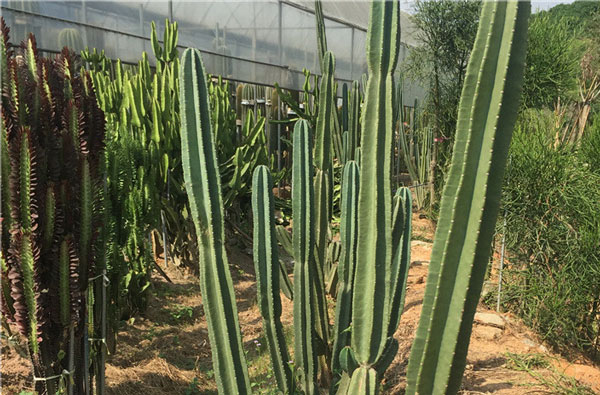
If you do want to care for your cactus, the best way to proceed is to cut off all of the old bloom stalks, to keep rotting material off of your cactus, to remove all of the old mummies to prevent mold, and to use a light fertilizer when it starts to bloom. Not all cacti need the same care, however. The Cereus Peruvianus will need high amounts of potassium and magnesium while it is in bloom, but after it is done, the nutrients are of no use to the Cereus Peruvianus plant. Instead of watering the cactus with fertilizer, apply a magnesium spray to prevent more flowers.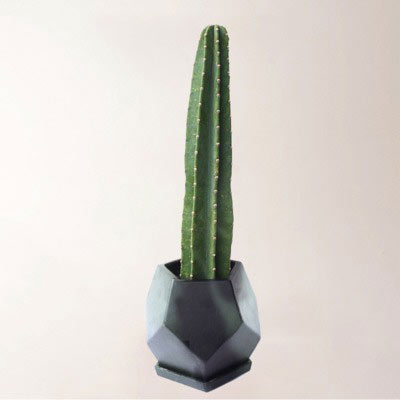
Cereus hildmannianus-A flowering plant that produces white flowers on occasional bloom.
Produces edible fruit.Features cylindrical segmented stems.
Cereus tetragonus-Native to North America Reach considerable heights and are often mistaken for fairy tale castles, common and dwarf succulents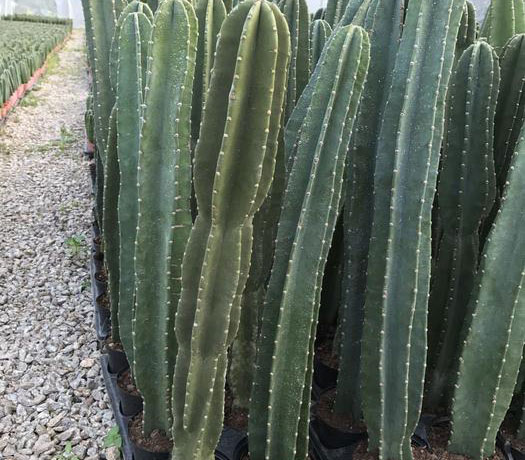
Where to Grow Cereus PeruvianusHow to Grow Cereus Peruvianus (Peruvian Apple Cactus)Cereus Peruvianus Propagation with SeedsCereus Peruvianus Propagation with Stem CuttingsCereus Peruvianus Propagation with OffsetsHow to Care for Cereus Peruvianus (Peruvian Apple Cactus)Cereus Peruvianus Light CareCereus Peruvianus Soil CareCereus Peruvianus WateringCereus Peruvianus Temperature & Humidity CareCereus Peruvianus Fertilizer CareCereus Peruvianus Pruning CareCereus Peruvianus Pests & Diseases CareVarieties of Cereus Peruvianus (Peruvian Apple Cactus)Cereus Peruvianus (Peruvian Apple Cactus) FAQIs Cereus Peruvianus Toxic? How fast does a Cereus Peruvianus grow?Can I grow Cereus Peruvianus in a container?
Where to Grow Cereus Peruvianus
Native to South America, the Cereus Peruvianus (Peruvian Apple Cactus) is a striking plant. It has a blueish-green hue, distinct spiny ribs, and can grow up to incredible, tree-like heights in the wild.The Cereus Peruvianus appreciates a warm, dry environment with minimal water, and plenty of light. This desert beauty will thrive in high light conditions, so placing it in a window where it will receive direct sunlight is ideal — preferably a southern or western facing window, as they are typically the brightest. This plant will not tolerate low light conditions.
If you are unsure about lighting conditions in your home or office, we have a guide for how to measure light in your space.

How to Grow Cereus Peruvianus (Peruvian Apple Cactus)
Cereus Peruvianus Propagation with Seeds
Germinating an cereus peruvianus (Peruvian Apple Cactus) seed and rearing the plant from infancy can prove to be challenging and time-consuming. You can propagate your Cereus Peruvianus (Peruvian Apple Cactus) by looking for and transplanting small offshoots that grow from the plant’s base. The offshoots adapt quickly and are more likely to be successful compared to growing using seeds.Cereus Peruvianus Propagation with Stem Cuttings
Another propagation method involves making small cuttings on the Cereus Peruvianus’s stem. The process requires good knowledge of the Cereus Peruvianus and an additional skill of making smooth cuts.Here is an insight on how to go about the procedure:
Identify a mature Cereus Peruvianus (Peruvian Apple Cactus) plant – A mature plant has several stem extensions from the main stem.
Make a cutting on the stem top part of the Cereus Peruvianus – Carefully make a smooth cutting on the top side of the stem you intend to propagate.
Allow the cutting to dry for about a week or two – Allow the cutting to dry out undisturbed for about one week before planting the dried cutting in an ideal potting medium.
Observe the cutting and analyze its growth pattern – Ensure you don't overwater the plant during this stage, as it can affect the Cereus Peruvianus’s future health and cause unwanted cases of root rot.
Once the Cereus Peruvianus plant is well established, it can be transplanted into the soil of the pot. If you want the growth of the plant to be faster, you can place it in areas where the light is brighter.
Cereus Peruvianus Propagation with Offsets
Cereus Peruvianus (Peruvian Apple Cactus) propagates from offsets. To be able to propagate from the mother plant, you might wait several years for the main plant to produce an offset. To start this process, use a sharp knife and remove an offset from the main plant. When you remove the offset, clean the extra soil from it. Before replanting, wait for a few days to allow it to callous. Use well-draining soil for your new Cereus Peruvianus succulent. Don’t forget to water when the soil dries out.
How to Care for Cereus Peruvianus (Peruvian Apple Cactus)
Cereus Peruvianus Light Care
The Cereus Peruvianus (Peruvian Apple Cactus) grows best in full sunlight. Greenhouses, conservatories, and rooms with plenty of windows are ideal for plants grown indoors.In addition to full sunlight, this cactus also prefers a relatively warm climate. In the spring and summertime, the Cereus Peruvianus grows best at temperatures between 60 and 75℉. During winter months, the Cereus Peruvianus slows its growth as temperatures cool. If you keep your cactus indoors, you should follow a seasonal growth schedule and keep your Cereus Peruvianus at between 50 and 55℉ through the winter.
Cereus Peruvianus Soil Care
These Cereus Peruvianus plants prefer a gritty, sharply draining mix. Use cactus soil or amend regular potting mix with sand and fine pumice up to 50% to improve texture and drainage.Cereus Peruvianus Watering
Cereus Peruvianus (Peruvian Apple Cactus) are resistant to salt spray, so they can spend summers outdoors even near the ocean. Being a cactus, Cereus Peruvianus likes bright light and just a little water. Water Cereus Peruvianus thoroughly when it is actively growing during the spring and summer. Give it considerably less water during the winter. Always let the soil dry out between waterings.Cereus Peruvianus Temperature & Humidity Care
These cacti thrive in warm temperatures and low humidity. They will thrive in temperatures above 70 ºF. They are cold intolerant, hardy to 25 ºF, though it is advisable to bring them indoors once night time temperatures consistently fall below 50 ºF.Cereus Peruvianus Fertilizer Care
Cereus Peruvianus are accustomed to growing in soils with limited nutrient values. Most Cereus Peruvianus can survive without the frequent need to add fertilizer to the soil, but it’s always recommended to add some fertilizer to boost your plant’s health.Identifying the type of nutrients missing in the soil is a crucial step to consider before adding extra fertilizer. Collect a soil sample and take it to the lab for analysis to gain a better understanding of the soil’s nutrient quality.
The main elements of cactus fertilizers include:
Nitrogen – Nitrogen encourages the growth of the leaves, stem, and other upper layers of the Cereus Peruvianus.
Potassium – Potassium is essential during the flowering and fruit development stage. Apply the fertilizer during the summer and spring months to encourage blooming and flowering.
Phosphorous – Phosphorous encourages root growth and seed germination.
You can opt to apply fertilizer by mixing the product with the soil during transplanting or adding small pellets on the surface that continuously dissolve after watering. The best alternative involves mixing the fertilizer with water and gently watering the Cereus Peruvianus plant using the concoction.

Cereus Peruvianus Pruning Care
Autumn is the best time for pruning your Cereus Peruvianus (Peruvian Apple Cactus). Prune it when the Cereus Peruvianus plant stops producing new branches or when it starts to become overgrown and becomes hard to pick up the fruits.Cereus Peruvianus Pests & Diseases Care
If your Cereus is in bloom, your Cereus Peruvianus plants are extremely vulnerable to getting diseases and pests. They are old and tired at this point and it is a good time to take a break from watering and fertilizing. The purpose of resting is so that your cactus can use all the energy it has stored up to produce the giant flowers that will soon be on display.If you do want to care for your cactus, the best way to proceed is to cut off all of the old bloom stalks, to keep rotting material off of your cactus, to remove all of the old mummies to prevent mold, and to use a light fertilizer when it starts to bloom. Not all cacti need the same care, however. The Cereus Peruvianus will need high amounts of potassium and magnesium while it is in bloom, but after it is done, the nutrients are of no use to the Cereus Peruvianus plant. Instead of watering the cactus with fertilizer, apply a magnesium spray to prevent more flowers.

Varieties of Cereus Peruvianus (Peruvian Apple Cactus)
Cereus Jamacaru-Tall plant growing to over 20ft. Flowering plant and produces edible fruitCereus hildmannianus-A flowering plant that produces white flowers on occasional bloom.
Produces edible fruit.Features cylindrical segmented stems.
Cereus tetragonus-Native to North America Reach considerable heights and are often mistaken for fairy tale castles, common and dwarf succulents

Cereus Peruvianus (Peruvian Apple Cactus) FAQ
Is Cereus Peruvianus Toxic?
Cereus Peruvianus sap can cause gastrointestinal upset to pets. Spines are sharp so it is advisable to keep out of reach of pets and small children.How fast does a Cereus Peruvianus grow?
Cereus Peruvianus (Peruvian Apple Cactus) fruits grow to enormous sizes over time and can reach heights of up to 33ft and a diameter of about 20 cm. The Cereus Peruvianus plants can multiply under ideal conditions and at certain times of the year.Can I grow Cereus Peruvianus in a container?
Yes, you can grow Cereus Peruvianus (Peruvian Apple Cactus) in a container or flower pot. Make sure to use the right potting mixture that has good drainage and lots of sand, and give it as much light as you can.Latest Updated
- Benefits of Bugleweed - 7 Science-backed Health Benefits
- Bugleweed Dangers & Side Effects - Is It Poisonous?
- How to Plant Evergreen Trees - What You Should Know
- When to Plant Evergreens - Grow Guide for Evergreen Trees
- 12 Wonderful Evergreen Shrubs for Your Garden
- 12 Popular Evergreen Plants with Pictures for Beginners
- When And How To Prune A Lilac Bush Like a Pro
- How to Grow & Care for Lilac Vine (Hardenbergia Violacea)
- Japanese Lilac Tree (Syringa Reticulata) Care & Propagation Guide
- Shumard Oak Pros and Cons - What to Know
Popular Articles
- Winter maintenance of Antirrhinum Majus
- How to Grow Terminalia Mantaly Tree
- How to Grow and Care for Crossostephium Chinense
- How to grow Antirrhinum Majus in spring
- Peristeria Elata (Dove Orchid) Profile: Info & Care Guide
- Underwatered Snake Plant (Sansevieria Trifasciata) - Signs And How To Fix
- How to Care for Brazilian Jasmine Plant (Mandevilla Sanderi)
- How to Grow & Care for Graptopetalum Purple Delight in Summer
- Rosa Chinensis (China Rose): Plant Growing & Care Tips
- How to Care for Baby Sun Rose (Aptenia Cordifolia)